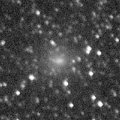
|
It reached up to 8.4 mag in October (Oct. 20, Marco Goiato). It is bright as 9.4 mag still now (Nov. 12, Marco Goiato). It keeps observable for a long time until February. It will keep 9 mag until the end of 2009. But in the Northern Hemisphere, it keeps very low after this. It locates a bit higher in the Southern Hemisphere.
Date(TT) R.A. (2000) Decl. Delta r Elong. m1 Best Time(A, h)
Nov. 21 19 27.54 -25 22.4 1.826 1.431 51 9.1 20:29 ( 76, 25)
Nov. 28 19 53.73 -24 19.8 1.876 1.455 50 9.3 20:38 ( 76, 23)
|
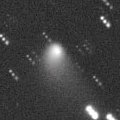
|
Now it is so bright as 9.5 mag (Oct. 26, Juan Jose Gonzalez). It keeps as bright as 9-10 mag for a long time until 2010 spring. It will be observable in good condition for a long time after this in the Northern Hemisphere. It keeps visible visually for one year until 2010 autumn.
Date(TT) R.A. (2000) Decl. Delta r Elong. m1 Best Time(A, h)
Nov. 21 12 27.95 14 22.6 2.648 2.309 59 9.3 3:02 (253, -1)
Nov. 28 12 41.71 15 53.7 2.581 2.328 64 9.3 2:57 (251, -1)
|
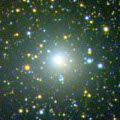
|
It reached up to 7.7 mag in summer (Aug. 13, Chris Wyatt). It is fading now, but still bright as 9.3 mag (Nov. 8, Juan Jose Gonzalez). It will be getting lower gradually after this, and will be too low to observe in December. It keeps observable for a long time after 2010 in the Northern Hemisphere. But in the Northern Hemisphere, it is only observable in the low sky in 2010 spring, then it will be unobservable after that.
Date(TT) R.A. (2000) Decl. Delta r Elong. m1 Best Time(A, h)
Nov. 21 19 16.16 -12 47.1 3.933 3.396 50 9.8 20:29 ( 86, 16)
Nov. 28 19 19.14 -13 54.3 4.059 3.422 44 9.9 20:38 ( 80, 10)
|
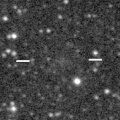
|
Although CCD observers reported it as faint as 15-16 mag, it looks bright visually as 12.9 mag (Nov. 18, Alan Hale). Juan Jose Gonzalez reported it was significantly bright as 9.2 mag on Nov. 18. It is expected to reach up to 10 mag in December. In the Southern Hemisphere, it keeps observable all through this apparition, although it becomes low in November and December. Especially, it will be observable in the excellent condition after January. In the Northern Hemisphere, it keeps observable in the evening low sky until late November when it becomes 11 mag. It will appear in the morning sky at 14 mag in late January, then it keeps observable while fading gradually.
Date(TT) R.A. (2000) Decl. Delta r Elong. m1 Best Time(A, h)
Nov. 21 18 37.66 -25 16.1 0.755 0.634 39 11.2 20:29 ( 70, 16)
Nov. 28 18 55.01 -28 28.7 0.639 0.609 36 10.5 20:38 ( 64, 14)
|
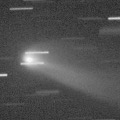
|
An outburst occured on Oct. 13, and it reached up to 8.5 mag on Oct. 15 (Toru Yusa). The central nucleus shined like a bright star, and the dust coma looked like 17P/Holmes in outburst. However, the comet returned to the normal state within a few days. Now it is 10.6 mag (Nov. 13, Marco Goiato). It will keep 10-11 mag until December. In the Northern Hemisphere, it keeps observable in good condition for a long time until 2010 spring when it becomes fainter than 18 mag.
Date(TT) R.A. (2000) Decl. Delta r Elong. m1 Best Time(A, h)
Nov. 21 6 19.19 -1 44.4 0.651 1.528 136 10.6 2:20 (180, 57)
Nov. 28 6 13.02 -0 20.5 0.669 1.578 144 10.9 1:46 (180, 55)
|
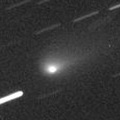
|
It has already brightened up to 11.2 mag (Oct. 26, Juan Jose Gonzalez). It will be getting higher after this. It will be observable bright as 9-10 mag in a good condition for a long time from winter to spring. It keeps observable until 2010 autumn when it fades down to 16 mag.
Date(TT) R.A. (2000) Decl. Delta r Elong. m1 Best Time(A, h)
Nov. 21 10 39.36 7 52.7 1.729 1.840 80 11.9 3:02 (241, 23)
Nov. 28 10 54.93 6 29.7 1.637 1.809 83 11.6 2:57 (241, 25)
|
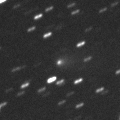
|
Now it is 13.6 mag, already visible visually (Oct. 26, Juan Jose Gonzalez). It will brighten rapidly after this. It will reach to 12 mag and become visible visually in winter. In the Northern Hemisphere, it keeps observable in good condition for a long time after this until 2010 spring when it fades out.
Date(TT) R.A. (2000) Decl. Delta r Elong. m1 Best Time(A, h)
Nov. 21 6 9.57 8 38.7 1.131 2.012 143 12.5 2:10 (180, 46)
Nov. 28 6 8.18 8 21.1 1.088 2.004 149 12.3 1:41 (180, 47)
|
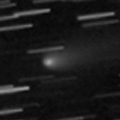
|
Brightening very rapidly, faster than expected. Now it is 13.8 mag and visible visually (Oct. 26, Juan Jose Gonzalez). It will be observable visually at 13-14 mag in winter. It keeps observable in good condition all through this apparition until next spring when it becomes fainter than 18 mag.
Date(TT) R.A. (2000) Decl. Delta r Elong. m1 Best Time(A, h)
Nov. 21 9 0.17 3 19.5 0.697 1.321 101 13.6 3:02 (222, 43)
Nov. 28 9 19.37 3 8.5 0.674 1.324 104 13.5 2:57 (221, 43)
|

|
Outbursts occured repeatedly since September, and it keeps visible visually. It is bright as 11.9 mag still now (Nov. 14, Marco Goiato).
Date(TT) R.A. (2000) Decl. Delta r Elong. m1 Best Time(A, h)
Nov. 21 9 52.42 12 8.2 6.052 6.176 92 13.8 3:02 (229, 28)
Nov. 28 9 53.48 11 56.9 5.940 6.177 99 13.8 2:57 (224, 31)
|
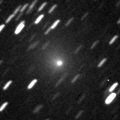
|
It brightened up to 8.5 mag in May and June (May 26, Juan Jose Gonzalez). Now it is fading, but still bright as 11.6 mag (Oct. 10, Marco Goiato). It will never be observable again in the Northern Hemisphere. In the Southern Hemisphere, it will be low temporarily in winter, but it keeps observable until when it fades out.
Date(TT) R.A. (2000) Decl. Delta r Elong. m1 Best Time(A, h)
Nov. 21 17 24.35 -53 26.0 3.283 2.585 38 13.9 20:29 ( 37, 19)
Nov. 28 17 45.18 -52 39.7 3.399 2.662 35 14.2 20:38 ( 36, 16)
|
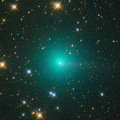
|
It brightened up to 6.7 mag in June (June 9, Marco Goiato). Now it is 13.3 mag (Nov. 7, Ken-ichi Kadota), a bit brighter than this ephemeris. It must be visible visually still now. It will be fading after this, and keeps observable until next spring when it becomes fainter than 18 mag.
Date(TT) R.A. (2000) Decl. Delta r Elong. m1 Best Time(A, h)
Nov. 21 13 34.54 14 37.8 3.157 2.590 47 14.0 3:02 (262,-15)
Nov. 28 13 37.34 16 10.0 3.108 2.649 53 14.2 2:57 (259,-12)
|

|
It brightened up to 11 mag in spring and summer. Now it is not observable. It will appear in the morning sky at 15 mag in early 2010. But it locates somewhat low in the Northern Hemisphere.
Date(TT) R.A. (2000) Decl. Delta r Elong. m1 Best Time(A, h)
Nov. 21 15 40.47 -21 7.6 3.332 2.345 1 14.1 3:02 (311,-16)
Nov. 28 15 55.51 -21 59.1 3.345 2.363 4 14.1 2:57 (311,-14)
|
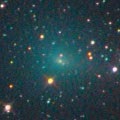
|
It brightened up to 8.8 mag in May and June (May 19, Juan Jose Gonzalez). Now it is still bright as 12.0 mag (Nov. 13, Marco Goiato). However, it will be too faint to see visually soon. It keeps observable in the evening sky for a long time until next spring when it becomes fainter than 18 mag.
Date(TT) R.A. (2000) Decl. Delta r Elong. m1 Best Time(A, h)
Nov. 21 23 5.60 -11 40.6 1.853 2.304 104 14.3 20:29 (135, 60)
Nov. 28 23 12.88 -10 44.0 1.976 2.346 99 14.6 20:38 (126, 54)
|

|
Now it is not observable. It will appear in the morning sky again in 2010 February. It will brighten up to 12-13 mag in 2010 summer. But it locates somewhat low in the Northern Hemisphere.
Date(TT) R.A. (2000) Decl. Delta r Elong. m1 Best Time(A, h)
Nov. 21 15 38.79 -17 47.9 3.505 2.519 2 14.3 3:02 (309,-18)
Nov. 28 15 52.46 -18 47.1 3.488 2.509 5 14.3 2:57 (308,-16)
|
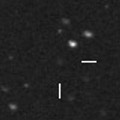
|
It is expected to reach up to 10 mag and to be observable in good condition in 2010 spring. Now it is not observable in the Northern Hemisphere. It will be unobservable also in the Southern Hemisphere in late November. Then it will appear in the morning sky at 13 mag in late January.
Date(TT) R.A. (2000) Decl. Delta r Elong. m1 Best Time(A, h)
Nov. 21 16 50.74 -35 24.8 3.479 2.582 21 14.8 20:29 ( 48, 3)
Nov. 28 16 59.10 -34 7.6 3.444 2.511 16 14.7 20:38 ( 45, -2)
|
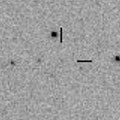
|
Now it is 15.7 mag (Sept. 19, Hidetaka Sato). It will be 14 mag from winter to spring in 2010. But the condition is bad. Now it is not observable in the Northern Hemisphere, but it is observable in good condition in the Southern Hemisphere. It keeps observable until mid January in the Southern Hemisphere. In the Northern Hemisphere, it will appear in the morning sky at 15 mag in late May in 2010, then it keeps observable while fading gradually after that.
Date(TT) R.A. (2000) Decl. Delta r Elong. m1 Best Time(A, h)
Nov. 21 19 45.03 -49 53.3 2.370 1.988 55 14.8 20:29 ( 51, 37)
Nov. 28 20 5.07 -47 4.5 2.387 1.952 52 14.7 20:38 ( 53, 34)
|
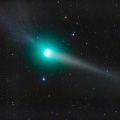
|
It passed near by the earth in late February, and it reached up to 4.9 mag (Feb. 23, Juan Jose Gonzalez). Now it is fading, but still bright as 15.4 mag (Oct. 18, Ken-ichi Kadota). It is observable at 15 mag in good condition until winter.
Date(TT) R.A. (2000) Decl. Delta r Elong. m1 Best Time(A, h)
Nov. 21 6 19.50 21 25.8 3.365 4.205 144 15.0 2:21 (180, 34)
Nov. 28 6 7.98 21 27.4 3.368 4.275 153 15.1 1:42 (180, 34)
|
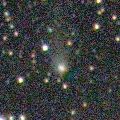
|
It brightened up to 11.5 mag in last summer (Aug. 4, Marco Goiato). Now it is 15.6 mag (Oct. 31, Hidetaka Sato). It keeps observable in good condition for a long time in the Southern Hemisphere. Now it became observable again also in the Northern Hemisphere. It will keep 15-16 mag until next spring.
Date(TT) R.A. (2000) Decl. Delta r Elong. m1 Best Time(A, h)
Nov. 21 5 53.80 -42 51.4 4.090 4.534 110 15.1 1:55 ( 0, 82)
Nov. 28 5 44.47 -42 33.7 4.111 4.586 112 15.2 1:18 ( 0, 82)
|

|
It brightned up to 10 mag from late 2008 to early 2009. Now it is fading. But it is still bright as 15.3 mag (Nov. 2, Ken-ichi Kadota). It will be observable in good condition again in winter at 15 mag. Then it may be still visible visually.
Date(TT) R.A. (2000) Decl. Delta r Elong. m1 Best Time(A, h)
Nov. 21 10 25.69 6 4.8 5.015 4.988 82 15.1 3:02 (240, 27)
Nov. 28 10 26.91 5 32.6 4.956 5.042 89 15.2 2:57 (236, 31)
|
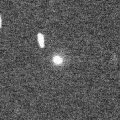
|
New periodic comet. Brightening very rapidly. Now it is 15.8 mag (Nov. 7, Ken-ichi Kadota). It will brighten up to 15 mag and will be observable in good condition in winter.
Date(TT) R.A. (2000) Decl. Delta r Elong. m1 Best Time(A, h)
Nov. 21 1 39.87 3 44.7 0.954 1.854 145 15.4 21:37 (180, 51)
Nov. 28 1 42.31 0 50.4 0.977 1.830 137 15.3 21:12 (180, 54)
|
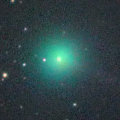
|
It has been observed bright as 8-9 mag from April to June. Now it is fading. It was still bright as 11.0 mag in July (July 12, Marco Goiato). However, no observations have been reported since August. So it may have faded out rapidly. In the Southern Hemisphere, it keeps observable in a good condition for a long time. In the Northern Hemisphere, it will never be observable again.
Date(TT) R.A. (2000) Decl. Delta r Elong. m1 Best Time(A, h)
Nov. 21 10 52.21 -59 2.6 3.531 3.232 64 15.3 3:02 (321, 46)
Nov. 28 10 47.70 -60 8.8 3.554 3.308 67 15.4 2:57 (324, 49)
|
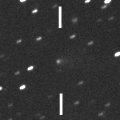
|
Now it is 15.6 mag (Nov. 9, J. M. Ruiz). It will brighten rapidly after this, and will be observable at 15 mag in good condition in winter and spring. It may be visible visually.
Date(TT) R.A. (2000) Decl. Delta r Elong. m1 Best Time(A, h)
Nov. 21 5 28.13 12 59.8 1.345 2.277 154 15.8 1:29 (180, 42)
Nov. 28 5 24.03 13 0.9 1.288 2.246 161 15.6 0:58 (180, 42)
|
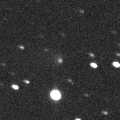
|
Now it is 16.6 mag (Oct. 24, Catalina Sky Survey). It will reach up to 12 mag in 2012, and will be observable visually at 12-13 mag for a long time from 2011 to 2013. In 2009, it is observable in good condition at 16 mag from summer to autumn. In the Northern Hemisphere, the comet will be low around its brightest seasons.
Date(TT) R.A. (2000) Decl. Delta r Elong. m1 Best Time(A, h)
Nov. 21 21 38.86 -0 37.6 8.132 8.160 88 15.7 20:29 (121, 37)
Nov. 28 21 38.06 -0 52.0 8.220 8.124 80 15.7 20:38 (113, 30)
|

|
It passed the perihelion in September, and brightened up to 14.6 mag (Sept. 19, Hidetaka Sato). It is fading now, but still bright as 15.5 mag (Nov. 3, Charles Bell). It keeps observable in good condition until February when it becomes fainter than 18 mag.
Date(TT) R.A. (2000) Decl. Delta r Elong. m1 Best Time(A, h)
Nov. 21 21 33.31 -2 54.9 1.239 1.531 86 16.0 20:29 (118, 38)
Nov. 28 21 49.80 0 33.6 1.342 1.584 84 16.2 20:38 (117, 32)
|

|
It brightened up to 13 mag and observed visually from 2007 to 2009. Due to the far distance, it is bright as 15.5 mag still now (Oct. 30, Ken-ichi Kadota). It will be observable in good condition again from winter to spring.
Date(TT) R.A. (2000) Decl. Delta r Elong. m1 Best Time(A, h)
Nov. 21 13 25.82 30 28.6 7.791 7.355 60 16.0 3:02 (247,-21)
Nov. 28 13 26.97 30 47.8 7.734 7.386 65 16.1 2:57 (244,-18)
|

|
It was observed as 15-16 mag in early 2009. In 2010, it will be observable at 15.5 mag in good condition from winter to spring.
Date(TT) R.A. (2000) Decl. Delta r Elong. m1 Best Time(A, h)
Nov. 21 12 58.49 -0 19.6 4.204 3.580 45 16.2 3:02 (270, 1)
Nov. 28 13 6.07 -1 2.3 4.131 3.582 50 16.2 2:57 (268, 4)
|
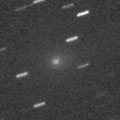
|
Fading slowly. Now it is 15.9 mag (Nov. 5, Ken-ichi Kadota). It keeps observable in good condition until February when it becomes fainter than 18 mag.
Date(TT) R.A. (2000) Decl. Delta r Elong. m1 Best Time(A, h)
Nov. 21 10 8.89 10 44.6 2.059 2.257 88 16.4 3:02 (233, 26)
Nov. 28 10 13.08 9 56.6 2.020 2.311 94 16.5 2:57 (230, 30)
|
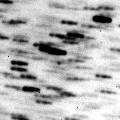
|
Now it is 16.4 mag (Nov. 5, Michael Jager). The condition is good in this apparition. It will approach to the earth down to 0.38 A.U., and will be observable in good condition at 16.5 mag in November. It keeps observable until that time after this. But it locates somewhat low in the Northern Hemisphere.
Date(TT) R.A. (2000) Decl. Delta r Elong. m1 Best Time(A, h)
Nov. 21 22 1.99 -5 23.3 0.380 1.070 91 16.4 20:29 (123, 45)
Nov. 28 22 50.44 -1 18.4 0.390 1.108 97 16.4 20:38 (130, 44)
|
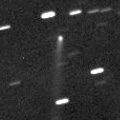
|
Now it is 16.1 mag (Nov. 3, Ken-ichi Kadota). It has a very long tail in spite of the distance. It passed the perihelion in 2009, but it was brighter in 2008. It will be fading after this, and will be fainter than 18 mag in next spring.
Date(TT) R.A. (2000) Decl. Delta r Elong. m1 Best Time(A, h)
Nov. 21 22 57.24 31 13.7 3.518 4.036 115 16.4 20:29 (159, 20)
Nov. 28 22 55.45 31 16.7 3.621 4.052 109 16.5 20:38 (151, 17)
|
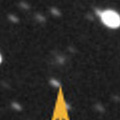
|
Now it is 17.4 mag (Nov. 3, Ken-ichi Kadota). The condition of this apparition is bad. It will reach up to 11-12 mag from spring to autumn in 2010, but it is not observable. It will be getting brighter gradually in the evening sky, but it will be too low to observe in January at 15 mag.
Date(TT) R.A. (2000) Decl. Delta r Elong. m1 Best Time(A, h)
Nov. 21 20 44.42 -2 2.8 2.653 2.578 74 16.6 20:29 (109, 28)
Nov. 28 20 52.09 -2 1.4 2.695 2.531 69 16.5 20:38 (104, 22)
|
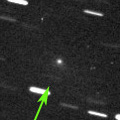
|
It brightened up to 11 mag in outburst in 2003. Now it is 17.0 mag (Nov. 3, Ken-ichi Kadota). It will be observable in good condition in winter. But it seems to brighten only up to 16 mag.
Date(TT) R.A. (2000) Decl. Delta r Elong. m1 Best Time(A, h)
Nov. 21 23 24.04 9 30.1 1.007 1.694 116 16.6 20:29 (157, 43)
Nov. 28 23 28.67 9 27.2 1.025 1.652 110 16.5 20:38 (148, 40)
|
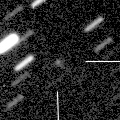
|
Now it is 17.5 mag (Nov. 5, Ken-ichi Kadota). It will be observable at 15.5 mag in the evening sky from winter to spring.
Date(TT) R.A. (2000) Decl. Delta r Elong. m1 Best Time(A, h)
Nov. 21 2 51.46 24 20.2 1.193 2.166 166 16.7 22:47 (180, 30)
Nov. 28 2 32.75 26 45.7 1.159 2.099 155 16.5 22:01 (180, 28)
|
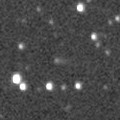
|
Now it is 16.5 mag (Nov. 10, R. Benavides). This comet tends to brighten after the perihelion passage. It will be observable at 16-17 mag in 2010 and 2011.
Date(TT) R.A. (2000) Decl. Delta r Elong. m1 Best Time(A, h)
Nov. 21 4 49.97 25 16.8 2.249 3.211 164 16.9 0:51 (180, 30)
Nov. 28 4 45.19 25 5.4 2.226 3.206 172 16.9 0:19 (180, 30)
|
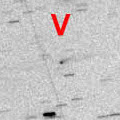
|
New periodic comet discovered very near by 29P/Schwassmann-Wachmann 1 and 81P/Wild 2. Now it is 16.8 mag (Oct. 19, Ken-ichi Kadota). It keeps observable in good condition at 17 mag for a while until winter.
Date(TT) R.A. (2000) Decl. Delta r Elong. m1 Best Time(A, h)
Nov. 21 10 30.49 12 22.5 1.644 1.827 83 16.9 3:02 (236, 22)
Nov. 28 10 41.07 12 25.9 1.607 1.866 88 16.9 2:57 (234, 24)
|

|
Now it is 18.0 mag (Nov. 21, C. Rinner, F. Kugel). It will be brightening rapidly after this. It will reach up to 15 mag from winter to spring, and will be observable in good condition.
Date(TT) R.A. (2000) Decl. Delta r Elong. m1 Best Time(A, h)
Nov. 21 9 59.87 17 57.7 2.145 2.406 92 17.1 3:02 (226, 22)
Nov. 28 10 8.40 17 37.1 2.045 2.389 97 16.9 2:57 (223, 25)
|
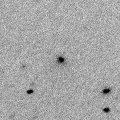
|
It became much brighter than expected. It was originally predicted to be 19 mag, but now it is 16.2 mag (Oct. 18, Ken-ichi Kadota). It will be observable in good condition at 17-18 mag until November.
Date(TT) R.A. (2000) Decl. Delta r Elong. m1 Best Time(A, h)
Nov. 21 0 30.65 10 28.6 1.418 2.206 132 17.2 20:29 (180, 44)
Nov. 28 0 31.38 11 10.3 1.487 2.211 125 17.4 20:38 (168, 43)
|
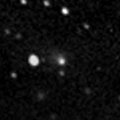
|
It brightened up to 15-16 mag in 2008 summer. Now it is 17.2 mag (Oct. 26, J. Gonzalez). It keeps observable at 17 mag in good condition for a long time until winter.
Date(TT) R.A. (2000) Decl. Delta r Elong. m1 Best Time(A, h)
Nov. 21 3 23.55 35 33.3 2.279 3.238 163 17.2 23:20 (180, 19)
Nov. 28 3 17.54 35 17.9 2.307 3.256 161 17.3 22:47 (180, 20)
|

|
Now it is 16.9 mag (Nov. 7, Katsumi Yoshimoto). It keeps observable at 17-18 mag for a long time until 2011.
Date(TT) R.A. (2000) Decl. Delta r Elong. m1 Best Time(A, h)
Nov. 21 23 51.28 80 27.8 4.501 4.994 114 17.3 20:29 (178,-26)
Nov. 28 23 19.43 79 22.1 4.500 4.981 113 17.2 20:38 (175,-25)
|
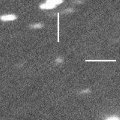
|
Now it is 17.8 mag (Oct. 20, Yasukazu Ikari). It keeps observable at 17 mag for a long time from 2010 to 2012.
Date(TT) R.A. (2000) Decl. Delta r Elong. m1 Best Time(A, h)
Nov. 21 2 53.92 19 7.9 7.737 8.705 167 17.3 22:51 (180, 36)
Nov. 28 2 48.69 18 52.1 7.758 8.689 159 17.3 22:18 (180, 36)
|
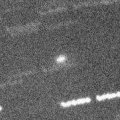
|
It will reach up to 17.5 mag and will be observable in good condition in November and December.
Date(TT) R.A. (2000) Decl. Delta r Elong. m1 Best Time(A, h)
Nov. 21 2 31.15 25 46.8 1.398 2.357 161 17.4 22:25 (180, 29)
Nov. 28 1 53.41 24 36.2 1.447 2.338 147 17.5 21:21 (180, 30)
|
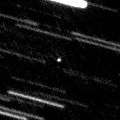
|
It passed the perihelion in June, but it was not observable, too close to the sun. Although it was predicted to be 13.5 mag, the STEREO spacecraft revealed that it brightened up to 10-11 mag, much brighter than expected. Now it is 16.4 mag (Oct. 29, S. Wakuda). It keeps observable at 16-17 mag until late autumn.
Date(TT) R.A. (2000) Decl. Delta r Elong. m1 Best Time(A, h)
Nov. 21 0 36.99 34 1.5 1.301 2.126 136 17.5 20:34 (180, 21)
Nov. 28 0 31.23 31 18.4 1.398 2.162 129 17.7 20:38 (171, 23)
|

|
It will be observable at 17.5 mag in good condition in early 2010 and early 2011.
Date(TT) R.A. (2000) Decl. Delta r Elong. m1 Best Time(A, h)
Nov. 21 5 56.85 20 10.3 2.757 3.642 149 17.9 1:58 (180, 35)
Nov. 28 5 53.07 20 12.1 2.703 3.633 157 17.9 1:26 (180, 35)
|

|
New periodic comet which brightened up to 14 mag in 2004 and 2005. It should be observable at 18 mag also around the aphelion. However, no observations have been reported since 2008 January. It seems to have faded out rapidly. Now it is fainter than 20.4 mag actually (Sept. 16, Leonid Elenin).
Date(TT) R.A. (2000) Decl. Delta r Elong. m1 Best Time(A, h)
Nov. 21 7 8.38 28 28.5 4.292 5.022 133 17.9 3:02 (182, 27)
Nov. 28 7 5.74 28 48.9 4.211 5.015 140 17.9 2:39 (180, 26)
|
|
![]()
 C/2005 L3 ( McNaught )
C/2005 L3 ( McNaught ) 74P/Smirnova-Chernykh
74P/Smirnova-Chernykh 64P/Swift-Gehrels
64P/Swift-Gehrels 107P/(4015) Wilson-Harrington
107P/(4015) Wilson-Harrington C/2008 P1 ( Garradd )
C/2008 P1 ( Garradd ) 43P/Wolf-Harrington
43P/Wolf-Harrington 157P/Tritton
157P/Tritton C/2009 U3 ( Hill )
C/2009 U3 ( Hill ) 203P/2008 R4 ( Korlevic )
203P/2008 R4 ( Korlevic ) P/2009 U6 ( LINEAR )
P/2009 U6 ( LINEAR ) 94P/Russell 4
94P/Russell 4 127P/Holt-Olmstead
127P/Holt-Olmstead 47P/Ashbrook-Jackson
47P/Ashbrook-Jackson C/2007 VO53 ( Spacewatch )
C/2007 VO53 ( Spacewatch ) C/2008 S3 ( Boattini )
C/2008 S3 ( Boattini ) C/2009 T3 ( LINEAR )
C/2009 T3 ( LINEAR ) (3200) Phaethon
(3200) Phaethon 31P/Schwassmann-Wachmann 2
31P/Schwassmann-Wachmann 2 P/2004 F3 ( NEAT )
P/2004 F3 ( NEAT )![]()





































